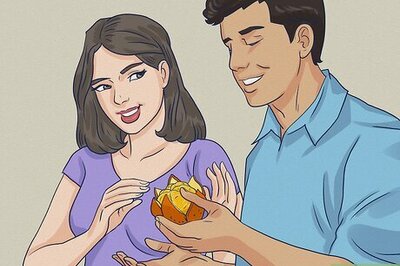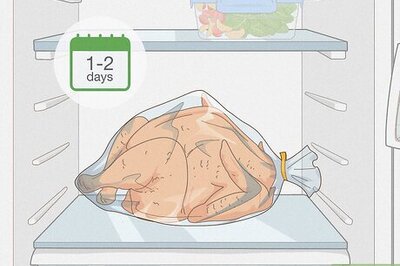
views
Cow Tipping: An Overview
Cow-tipping is the act of pushing a cow over for sport or entertainment. This practice is generally considered to be an urban legend, originating from the stereotype that people who live in rural areas don’t have a ton of entertainment options and resort to tipping cows for fun. This belief is also upheld by the misconception that cows sleep while standing, like horses, and are therefore vulnerable to being tipped over when sleeping. Although cows can sleep on their feet, it’s a very light sleep that they can easily be woken up from as they tend to be on high alert at all times. Cows lay down to enter deep sleep, contrary to popular belief.
Tipping a cow over would require multiple people and lots of strength. Full grown cows weigh over 1000 lbs (453 kg) on average and have a low center of gravity, so tipping one over would take a ton of effort from multiple participants. Scientifically speaking, force is based on weight and measured in newtons. Tipping a cow over would require about 3,000 newtons, or force exerted by nearly 700 lbs (317 kg), which is impossible for a single person to do. According to these numbers, it would take more than four, 150 lbs (68 kg) people to push over a cow. Certain other factors add to the difficulty of cow-tipping, like a cow’s ability to brace itself, their heightened awareness due to their keen sense of smell and hearing, and how unlikely they are to allow themselves to be tipped over without fighting back.
Origins of Urban Legend
The myth of cow-tipping has roots in Ancient Rome. The idea that certain animals cannot get back up on their feet when tipped over dates back to Julius Caesar and Pliny the Elder. In ‘‘The Natural History’’, it was documented that European elk did not posses knee joints and could therefore not get up if they fell. Ultimately, this idea proved to be false. A similar claim was made about elephants in 1255, further cementing this belief in popular culture. Cows didn’t come into the picture until the 1970s, when stories of “friends” that had gone cow-tipping began making the rounds. Movies like ‘‘Tommy Boy’’ and ‘‘Heathers’’ featured iconic cow-tipping scenes that continued fueling the urban legend.
How to Hypothetically Tip Over a Cow
Gather at least 4 people. In theory, successfully tipping over a cow would require at least four people with an average weight of 150 lbs (68 kg) that can exert a force of 3000 newtons, or 700 lbs (317 kg). Cow-tipping truly embodies the expression, “the more, the merrier,” because it could take up to 14 people to tip over a cow, even in ideal conditions.
Find a younger, smaller cow. The smaller the cow, the bigger your chances of tipping success. Some miniature breeds weigh an average of 450-850 lbs, potentially rendering them easier to tip with less participants. Moreover, if the bovine in question does object to your tipping, a smaller cow may put up less of a fight as they have less power and are less experienced in general.
Make sure they’re sleeping before sneaking up on them. The most important thing to note is that cows don’t sleep on their feet as much as they simply doze off while chewing their cud. The fact that they’re half-awake, coupled with their keen sense of hearing and smell make them easy to startle, and thus, hard to surprise. Try to identify a cow that’s clearly snoozing before you get too close.
Act as quickly as possible. If you manage to find a group of people in a cow-tipping mood and locate a relatively small and docile cow, you must act fast due to a variety of reasons. First, the cow can sense you’re coming and is ready to scurry off or kick you in defense, so being stealthy is key. If your group manages to surround the cow, you then have to work together to exert maximum effort in the same direction, aiming to tip their heavy center over their hooves. Human biology throws another wrench in the mix, as speed and strength don’t tend to work well together. As it turns out, the faster muscles contract, the less force they can exert.
Leave the scene. If your group somehow manages to tip over a cow– do not stick around to celebrate. The cow will be able to get back up pretty quickly– perhaps to exact their revenge on you– and surrounding cows may not be too friendly, either. Additionally, there is a chance of injury for your group as cows are large herd animals that could still kick, crush, and trample. The safest way to tip over a cow is not to tip one over at all.
FAQ
Can you tip a cow over? In theory, a group of 4 or more people can tip a cow over. Choosing a smaller, sleeping cow, acting quickly, and exerting a maximum concentrated group effort could result in the tipping of a cow. However, there isn’t any concrete cow-tipping evidence that supports this practice on any level and is an urban legend above any real world occurrence.
Is cow-tipping safe? No, cow-tipping is not considered safe, or possible, by many standards. There is risk of injury to both the cow and the tipping party as these bovines can weigh upwards of 1400 lbs (635 kg). No one should attempt to tip over a cow, alone or in a group. Many cow-tipping stories involve a group of drunk people in the country who think up this idea as a means of entertaining. Being drunk would only make this practice more dangerous and is not advisable.
What is cow-casting? Cow-casting is a method of bringing the cow to a laying position. Done mainly for medical procedures, like birthing and c-sections, cow-casting involves using a system of ropes to securely and humanely lower the animal to the ground. The ropes must be woven in a specific pattern, carefully avoiding blocking the cow’s airways along with other sensitive areas like the udders. This practice requires multiple people, a focused effort, and typically, a sedated cow.



















Comments
0 comment